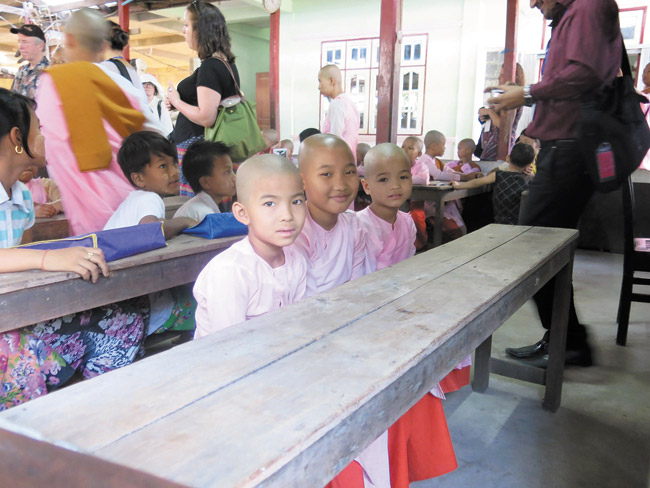Scarred But Hopeful In Myanmar
Umar was one of several Muslim journalists I enjoyed talking with, including two from Iraq. They, Umar and Shakir Ullah, a producer for Radio Pakistan, also were part of a tour of Myanmar religious sites that, in just three hours, allowed me to express my own faith and theology in a rare way, all in the Thingangyun neighborhood of Yangon. By the way, it is said that for every 100 people in Myanmar, 90 are Buddhist, five Christian, three Muslim and two Hindu – though our guide this day, Paula Helfrich (who sends regards to her Honolulu pal Hector Venegas), says the ongoing national census may alter that somewhat – she and others expect a greater percentage of non-Buddhists. Given recent attacks by Buddhists in Rakhine state on the Rohingya Muslim minority, I was especially interested in this opportunity to visit four different faiths in a crowded neighborhood.
mw-chapman-041614-myanmar-2
First stop was St. Joseph’s Roman Catholic Church – Portuguese priests brought Catholicism to Myanmar in 1514. There I prayed and made the sign of the cross.
Next we visited a Hindu temple, where a young man on bamboo scaffolding was repainting Hindu figures. Inside, after a prayer of thanks to Lord Shiva, I received a red dot on the forehead.
From there it was on to a Paker Mosque, established 153 years ago. It was my first mosque, and only men are allowed in the holy of holies. Following the lead of my new Muslim friends, I washed hands and feet, entered the mosque, prayed, knelt and bowed toward Mecca, again offering thanks. Afterward, they said they “appreciate your kneeling and bowing and praying to Allah.”
“I was trying to follow along with you guys, but probably screwed it all up.”
“No matter,” an Iraqi said. “In the Koran, it says if you pray, Allah will hear.”
Finally, it was on to Paya Thon Zu Buddhist Temple and Monastery, and adjacent nunnery and orphanage. In recent years Buddhist philosophy has become attractive to me, and eminently sensible – in no small part from having covered the Dalai Lama’s last two visits to Hawaii and last year’s trip to interview the head of Shinnyo-en in Japan – and I explained that attraction to my Muslim friends.
“But you were raised Christian?” one of the Iraqis said.
“Yes, I was once in a seminary, and the way I see God now is as the most immense diamond you can imagine, larger than that even, with infinite facets, and if you are lucky one of those facets will reflect light on you and have meaning. I am very lucky because several of God’s facets shine for me. The greatest human conceit is to assume just one religion, much less one sect, expresses the complete and only truth about God.”
“This is how I believe too,” an Iraqi said. “But do you speak to your family of such things?”
“My children, yes, of course. But with other relatives, it doesn’t come up.”
“This is my situation, too – Islam has become too harsh, but I cannot speak of this to my family.”
“But this faith is in your heart.”
“Yes.” “Then you are blessed.” Early the next morning I was checking out of the hotel and ran into one of my Muslim friends.
“Ah, Mr. Don, it was nice to meet you.”
“Thank you, I enjoyed your company very much.”
We bowed, wished each other safe travels and “Go with God.”
It is such interactions, as well as those I’ve written about in the previous two columns, that make me so grateful to have been associated with the East-West Center as a former fellow since 2005. The next International Media Conference, in 2016, is already in my calendar. Can’t wait for the announcement of the site. My suggestion: North Korea.
dchapman@midweek.com







